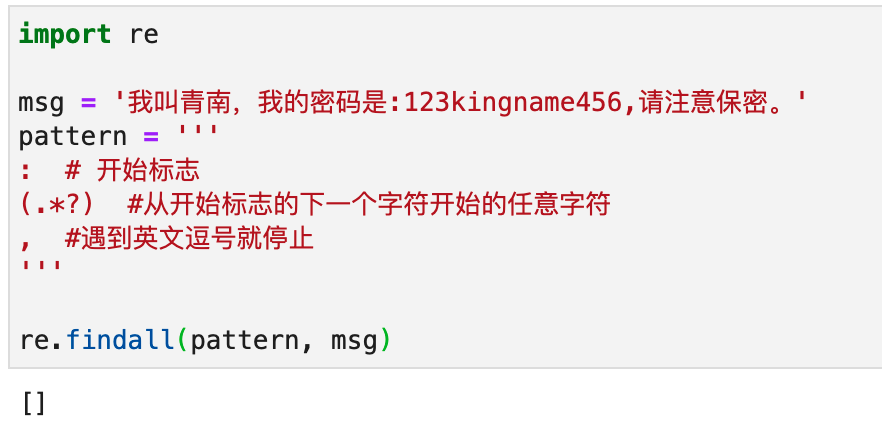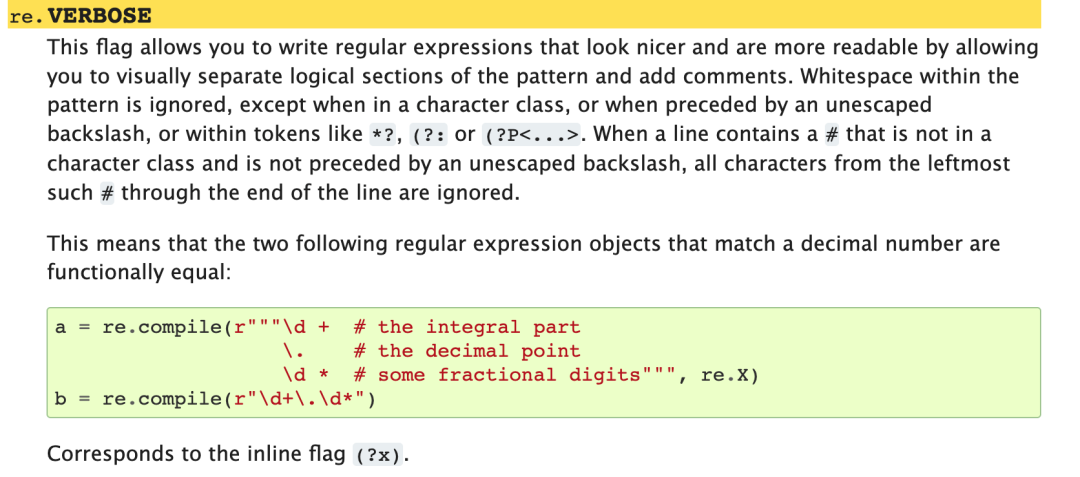让你的正则表达式可读性提高一百倍
↑ 关注 + 星标 ,每天学Python新技能
后台回复【大礼包】送你Python自学大礼包
阅读本文大概需要 4 分钟。
正则表达式这个东西,强大是强大,但写出来跟个表情符号一样。自己写的表达式,过一个月来看,自己都不记得是什么意思了。比如下面这个:
pattern = r"((?:\(\s*)?[A-Z]*H\d+[a-z]*(?:\s*\+\s*[A-Z]*H\d+[a-z]*)*(?:\s*[\):+])?)(.*?)(?=(?:\(\s*)?[A-Z]*H\d+[a-z]*(?:\s*\+\s*[A-Z]*H\d+[a-z]*)*(?:\s*[\):+])?(?![^\w\s])|$)"
有没有什么办法提高正则表达式的可读性呢?我们知道,提高代码可读性的方法之一就是写注释,那么正则表达式能不能写注释呢?
例如对于下面这个句子:
msg = '我叫青南,我的密码是:123kingname456,请注意保密。'
我要提取其中的密码123kingname456,那么我的正则表达式可能是这样的:
pattern = ':(.*?),'
我能不能把它写成这样:
pattern = '''
: # 开始标志
(.*?) #从开始标志的下一个字符开始的任意字符
, #遇到英文逗号就停止
'''
这样写就清晰多了,每个部分是什么作用全都清清楚楚。
但显然直接使用肯定什么都提取不到,如下图所示:

但我今天在逛 Python 正则表达式文档[1]的时候,发现了一个好东西:

使用它,可以让你的正则表达式拥有注释,如下图所示:

re.VERBOSE也可以简称为re.X,如下图所示:

本文最开头的复杂正则表达式,使用了注释以后,就会变得更可读:
pattern = r"""
( # code (capture)
# BEGIN multicode
(?: \( \s* )? # maybe open paren and maybe space
# code
[A-Z]*H # prefix
\d+ # digits
[a-z]* # suffix
(?: # maybe followed by other codes,
\s* \+ \s* # ... plus-separated
# code
[A-Z]*H # prefix
\d+ # digits
[a-z]* # suffix
)*
(?: \s* [\):+] )? # maybe space and maybe close paren or colon or plus
# END multicode
)
( .*? ) # message (capture): everything ...
(?= # ... up to (but excluding) ...
# ... the next code
# BEGIN multicode
(?: \( \s* )? # maybe open paren and maybe space
# code
[A-Z]*H # prefix
\d+ # digits
[a-z]* # suffix
(?: # maybe followed by other codes,
\s* \+ \s* # ... plus-separated
# code
[A-Z]*H # prefix
\d+ # digits
[a-z]* # suffix
)*
(?: \s* [\):+] )? # maybe space and maybe close paren or colon or plus
# END multicode
# (but not when followed by punctuation)
(?! [^\w\s] )
# ... or the end
| $
)
"""


参考资料

正则表达式文档: https://docs.python.org/3/library/re.html#re.VERBOSE
评论
